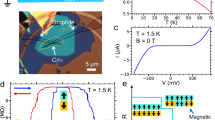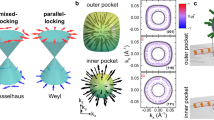Abstract
The use of spin waves as information carriers in spintronic devices can substantially reduce energy losses by eliminating the ohmic heating associated with electron transport. Yet, the excitation of short-wavelength spin waves in nanoscale magnetic systems remains a significant challenge. Here, we propose a method for their coherent generation in a heterostructure composed of antiferromagnetically coupled magnetic layers. The driven dynamics of naturally formed nanosized stacked pairs of magnetic vortex cores is used to achieve this aim. The resulting spin-wave propagation is directly imaged by time-resolved scanning transmission X-ray microscopy. We show that the dipole-exchange spin waves excited in this system have a linear, non-reciprocal dispersion and that their wavelength can be tuned by changing the driving frequency.
This is a preview of subscription content, access via your institution
Access options
Subscribe to this journal
Receive 12 print issues and online access
$259.00 per year
only $21.58 per issue
Buy this article
- Purchase on Springer Link
- Instant access to full article PDF
Prices may be subject to local taxes which are calculated during checkout





Similar content being viewed by others
References
Bloch, F. Zur theorie des ferromagnetismus. Z. Phys. 61, 206–219 (1930).
Holstein, T. & Primakoff, H. Field dependence of the intrinsic domain magnetization of a ferromagnet. Phys. Rev. 58, 1098–1113 (1940).
Dyson, F. J. General theory of general spin wave interactions. Phys. Rev. 102, 1217–1230 (1956).
Gurevich, A. G. & Melkov, G. A. Magnetization Oscillations and Waves (CRC, 1996).
Demidov, V. E., Urazhdin, S. & Demokritov, S. O. Direct observation and mapping of spin waves emitted by spin-torque nano-oscillators. Nature Mater. 9, 984–988 (2010).
Madami, M. et al. Direct observation of a propagating spin wave induced by spin-transfer torque. Nature Nanotech. 6, 635–638 (2011).
Voigt, K. et al. Realization of a spin-wave multiplexer. Nature Commun. 5, 3727 (2014).
Yu, H. et al. Omnidirectional spin-wave nanograting coupler. Nature Commun. 4, 2702 (2013).
Macià, F., Backes, D. & Kent, A. D. Stable magnetic droplet solitons in spin-transfer nanocontacts. Nature Nanotech. 9, 992–996 (2014).
Stancil, D. D. Theory of Magnetostatic Waves Ch. 5 (Springer, 1993).
Demidov, V. E. et al. Excitation of short-wavelength spin waves in magnonic waveguides. Appl. Phys. Lett. 99, 082507 (2011).
Demokritov, S. O. et al. Bose–Einstein condensation of quasi-equilibrium magnons at room temperature under pumping. Nature 443, 430–433 (2006).
Slonczewski, J. C. Current-driven excitation of magnetic multilayers. J. Magn. Magn. Mater. 159, L1–L7 (1996).
Berger, L. Emission of spin waves by a magnetic multilayer traversed by a current. Phys. Rev. B 54, 9353–9358 (1996).
Tsoi, M. et al. Generation and detection of phase-coherent current-driven magnons in magnetic multilayers. Nature 406, 46–48 (2000).
Slonczewski, J. C. Exitation of spin waves by an electric current. J. Magn. Magn. Mater. 195, L261–L268 (1999).
Hoefer, M. A., Silva, T. J. & Stiles, M. D. Model for a collimated spin-wave beam generated by a single-layer spin torque nanocontact. Phys. Rev. B 77, 144401 (2008).
Bonetti, S. et al. Experimental evidence of self-localized and propagating spin wave modes in obliquely magnetized current-driven nanocontacts. Phys. Rev. Lett. 105, 217204 (2010).
Slavin, A. & Tiberkevich, V. Spin wave mode excited by spin-polarized current in a magnetic nanocontact is a standing self-localized wave bullet. Phys. Rev. Lett. 95, 237201 (2005).
Demidov, V. E. et al. Magnetic nano-oscillator driven by pure spin current. Nature Mater. 11, 1028–1031 (2012).
Urazhdin, S. et al. Nanomagnonic devices based on the spin-transfer torque. Nature Nanotech. 9, 509–513 (2014).
Kittel, C. Physical theory of ferromagnetic domains. Rev. Mod. Phys. 21, 541 (1949).
Feldtkeller, E. & Thomas, H. Struktur und energie von blochlinien in dünnen ferromagnetischenen schichten. Phys. Kondens. Materie 4, 8–14 (1965).
Shinjo, T., Okuno, T., Hassdorf, R., Shigeto, K. & Ono, T. Magnetic vortex core observation in circular dots of permalloy. Science 289, 930–932 (2000).
Tretiakov, O. A. & Tchernyshyov, O. Vortices in thin ferromagnetic films and the skyrmion number. Phys. Rev. B 75, 012408 (2007).
Guslienko, K. Y. Magnetic vortex state stability, reversal and dynamics in restricted geometries. J. Nanosci. Nanotech. 8, 2745–2760 (2008).
Thiele, A. A. Steady-state motion of magnetic domains. Phys. Rev. Lett. 30, 230–233 (1973).
Völkel, A. R., Wysin, G. M., Mertens, F. G., Bishop, A. R. & Schnitzer, H. J. Collective-variable approach to the dynamics of nonlinear magnetic excitations with application to vortices. Phys. Rev. B 50, 12711–12720 (1994).
Choe, S.-B. et al. Vortex core-driven magnetization dynamics. Science 304, 420–422 (2004).
Vansteenkiste, A. et al. X-ray imaging of the dynamic magnetic vortex core deformation. Nature Phys. 5, 332–334 (2009).
Buess, M. et al. Fourier transform imaging of spin vortex eigenmodes. Phys. Rev. Lett. 93, 077207 (2004).
Perzlmaier, K. et al. Spin-wave eigenmodes of permalloy squares with a closure domain structure. Phys. Rev. Lett. 94, 057202 (2005).
Kammerer, M. et al. Magnetic vortex core reversal by excitation of spin waves. Nature Commun. 2, 279 (2011).
Buchanan, K. et al. Magnetic remanent states and magnetization reversal in patterned trilayer nanodots. Phys. Rev. B 72, 134415 (2005).
Wintz, S. et al. Control of vortex pair states by post-deposition interlayer exchange coupling modification. Phys. Rev. B 85, 134417 (2012).
Guslienko, K. Y. u., Buchanan, K. S., Bader, S. D. & Novosad, V. Dynamics of coupled vortices in layered magnetic nanodots. Appl. Phys. Lett. 86, 223112 (2005).
Grünberg, P., Schreiber, R., Pang, Y., Brodsky, M. B. & Sowers, H. Layered magnetic structures: evidence for antiferromagnetic coupling of Fe layers across Cr interlayers. Phys. Rev. Lett. 57, 2442–2445 (1986).
Nolle, D. et al. Unique characterization possibilities in the ultra high vacuum scanning transmission X-ray microscope (UHV-STXM) ‘MAXYMUS’ using a rotatable permanent magnetic field up to 0.22 T. Rev. Sci. Instrum. 83, 046112 (2012).
Raabe, J. et al. PolLux: a new facility for soft X-ray spectromicroscopy at the Swiss light source. Rev. Sci. Instrum. 79, 113704 (2008).
Cherepov, S. S. et al. Core–core dynamics in spin vortex pairs. Phys. Rev. Lett. 109, 097204 (2012).
Hänze, M., Adolff, C. F., Velten, S., Weigand, M. & Meier, G. Two-body problem of core-region coupled magnetic vortex stacks. Phys. Rev. B 93, 054411 (2016).
Damon, R. W. & Eshbach, J. R. Magnetostatic modes of a ferromagnetic slab. J. Phys. Chem. Solids 19, 308–320 (1961).
Grünberg, P. Magnetostatic spin-wave modes of a heterogeneous ferromagnetic double layer. J. Appl. Phys. 52, 6824 (1981).
Landau, L. & Lifshitz, E. On the theory of the dispersion of magnetic permeability in ferromagnetic bodies. Phys. Z. Sowjetunion. 8, 153–169 (1935).
Scheinfein, M. R. LLG Micromagnetics Simulator; http://llgmicro.home.mindspring.com
Kravchuk, V. P., Gaididei, Y. & Sheka, D. D. Nucleation of a vortex–antivortex pair in the presence of an immobile magnetic vortex. Phys. Rev. B 80, 100405(R) (2009).
Lee, K. S. & Kim, S. K. Radiation of spin waves from magnetic vortex cores by their dynamic motion and annihilation processes. Appl. Phys. Lett. 87, 192502 (2005).
Hertel, R., Gliga, S., Fähnle, M. & Schneider, C. M. Ultrafast nanomagnetic toggle switching of vortex cores. Phys. Rev. Lett. 98, 117201 (2007).
Schütz, G. et al. Absorption of circularly polarized X rays in iron. Phys. Rev. Lett. 58, 737–740 (1987).
Gilbert, T. L. A phenomenological theory of damping in ferromagnetic materials. IEEE Trans. Magn. 40, 3443–3449 (2004).
Acknowledgements
The authors thank A. Puzic, K.W. Chou and M.-Y. Im for their contributions to the preparation of this work, C. Quitmann, H. Stoll, G. Schütz, M. Curcic, R. Mattheis, J. McCord, S. Gemming, V. Sluka, K. Schultheiss and R. Hübner for their support and discussions, as well as V. Kühn, J. Kerbusch and K. Kirsch for their assistance in sample fabrication. Most experiments were performed at the Maxymus endstation at BESSY2, HZB (Berlin, Germany). The authors acknowledge HZB for the allocation of synchrotron radiation beam time. Some experiments were performed at the Pollux endstation at SLS, PSI (Villigen, Switzerland). Pollux is financed by BMBF under contracts nos. 05KS4WE1/6 and 05KS7WE1. Technical support by M. Bechtel and B. Sarafimov at the scanning transmission X-ray microscopy set-ups is gratefully acknowledged. This work was supported in part (V.T. and A.S.) by a grant from DARPA MTO/MESO (nos. N66001-11-1-4114), grant no. ECCS-1305586 from the National Science Foundation, and by contracts from the US Army TARDEC, RDECOM. V.T. and A.S. acknowledge the Center for NanoFerroic Devices (CNFD) and the Nanoelectronics Research Initiative (NRI) for partial support of this work.
Author information
Authors and Affiliations
Contributions
S.W., M.W. and J.R. performed the experiments. S.W. fabricated the samples and performed the simulations. V.T. and A.S. calculated the dispersion relations. S.W. and A.S. wrote the manuscript. All authors discussed the data and commented on the manuscript.
Corresponding author
Ethics declarations
Competing interests
The authors declare no competing financial interests.
Supplementary information
Supplementary information
Supplementary information (PDF 2973 kb)
Supplementary information
Supplementary Movie 1 (MOV 635 kb)
Supplementary information
Supplementary Movie 2 (MOV 693 kb)
Supplementary information
Supplementary Movie 3 (MOV 648 kb)
Supplementary information
Supplementary Movie 4 (MOV 659 kb)
Supplementary information
Supplementary Movie 5 (MOV 315 kb)
Supplementary information
Supplementary Movie 6 (MOV 221 kb)
Supplementary information
Supplementary Movie 7 (MOV 305 kb)
Supplementary information
Supplementary Movie 8 (MOV 228 kb)
Supplementary information
Supplementary Movie 9 (MOV 230 kb)
Supplementary information
Supplementary Movie 10 (MOV 218 kb)
Supplementary information
Supplementary Movie 11 (MOV 171 kb)
Supplementary information
Supplementary Movie 12 (MOV 214 kb)
Supplementary information
Supplementary Movie 13 (MOV 216 kb)
Supplementary information
Supplementary Movie 14 (MOV 218 kb)
Supplementary information
Supplementary Movie 15 (MOV 211 kb)
Supplementary information
Supplementary Movie 16 (MOV 296 kb)
Supplementary information
Supplementary Movie 17 (MOV 208 kb)
Supplementary information
Supplementary Movie 18 (MOV 200 kb)
Supplementary information
Supplementary Movie 19 (MOV 14693 kb)
Rights and permissions
About this article
Cite this article
Wintz, S., Tiberkevich, V., Weigand, M. et al. Magnetic vortex cores as tunable spin-wave emitters. Nature Nanotech 11, 948–953 (2016). https://doi.org/10.1038/nnano.2016.117
Received:
Accepted:
Published:
Issue Date:
DOI: https://doi.org/10.1038/nnano.2016.117
This article is cited by
-
Observing high-k magnons with Mie-resonance-enhanced Brillouin light scattering
Communications Physics (2023)
-
Imaging and phase-locking of non-linear spin waves
Nature Communications (2022)
-
Electrical characterisation of higher order spin wave modes in vortex-based magnetic tunnel junctions
Communications Physics (2021)
-
Nanoscale magnonic Fabry-Pérot resonator for low-loss spin-wave manipulation
Nature Communications (2021)
-
Inverse-design magnonic devices
Nature Communications (2021)



